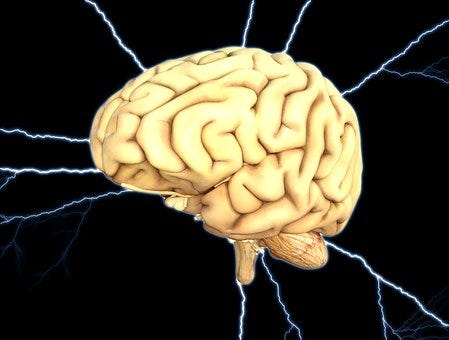
This article follows on from part 1 (click here) where I discussed demonic possession. It’s important to have read that, in order to put what follows in context. There will also be some references, and comparisons made, to the material there.
I’ll turn now to the work of another therapist, Wilson Van Dusen. The material here is different from the previous three, in that we are not dealing with people who have been completely possessed, rather with those who seem to be under attack by invading spirits, but who are tormented by this, and doing everything they can to resist, but on the whole unsuccessfully. They are diagnosed as mentally ill, or schizophrenic.
Van Dusen is a follower of the Swedish scientist and mystic theologian Emanuel Swedenborg, so I’ll briefly describe the latter’s life. The purpose of this is to demonstrate that we are dealing with one of the greatest intellects of all time, so that when we come to the material relevant to this article, nobody will be able to dismiss him as an eccentric or crank, rather someone who should be taken extremely seriously.
I have put together the following account from Van Dusen’s The Presence of Other Worlds¹, and also Colin Wilson’s Afterlife², in which he discusses the former’s book, specifically the chapter ‘The Presence of Spirits in Madness’, which is the reason for my title. (Everything in quotation marks comes from one of these two sources.)
Swedenborg (1688–1772) received a classical university education with a heavy emphasis on Latin, Greek, and literature to the level of a master’s degree. His earliest published works were Latin poetry, and he was fluent in nine languages. He had a prestigious scientific career, publishing 150 early works, even though his followers considered his later writings more important.
“He had exhausted all the known sciences after founding several of them”. Listed are: chemistry, engineering, physics, mathematics, mineralogy, geology, paleontology, anatomy, physiology, astronomy, optics, metallurgy, cosmogony, cosmology, and psychology. “He can be said to have founded several sciences, such as crystallography”. He made discoveries about the human brain, being the first to discover the function of the cerebellum. He was also the originator of the nebular hypothesis in relation to the formation of the solar system.
Surprising though this may seem, he somehow managed to find time for a few hobbies: bookbinding, watchmaking, cabinetmaking, engraving, lens grinding and more.
Crucially, in the middle period of his life he developed an interest in psychology and the inner world. He had begun to have powerful dreams. He went through an extensive period of self-exploration, and there was an “opening of the spiritual worlds to him”. He spent “thirteen years of journeying in the worlds beyond this one”. “He claimed to have actually visited heaven and hell, and to have held long theological discussions with angels and deceased religious teachers”. He then wrote extensively about his experiences, and his theological conclusions. Sometimes he may have sounded like a crank, “except that he was able to offer some impressive evidence that he really had been in touch with the dead”, revealing things to living people he could not possibly have known about their deceased relatives.
Wilson van Dusen
This is where Van Dusen comes in. He was already familiar with Swedenborg’s writings, following a series of religious visions: “it seemed to me that Swedenborg was talking about what I had experienced”. He then started studying him in depth.
He later worked for sixteen years as a clinical psychologist in a mental hospital, where he examined thousands of mentally ill persons, who were hearing, and being tormented by, inner voices. Rather than take the conventional route of dismissing these as ‘hallucinations’, he tried to gain a greater understanding of what was actually going on. This would not necessarily be easy because, as might be expected, “most patients who are hallucinating prefer to keep their experiences to themselves, since they know it will be taken as a proof that they are mad”.
He began by asking an unusually cooperative patient whether he could talk directly with her inner voices. He then sought other patients, and held dialogues with their voices and, to his surprise, “there was great consistency in what was reported independently by different patients”, “even though they had no contact with each other”. “The hallucinations were all so similar. This in itself seems baffling. After all, one would expect to find as many different types of hallucinations as there are people. This either implies some basic similarity in the parts of our minds that create hallucinations, or something far stranger”.
Now we come to the heart of the matter: “One consistent finding was that patients felt they had contact with another world or order of beings. Most thought these other persons were living”. All objected to the term ‘hallucination’ and coined their own terms. For anyone who has followed this series from the beginning, this is the precise point of dispute between Ted Wade, following on from Julian Jaynes, and myself. They claim that the supernatural, and therefore the belief that inner voices are real, are illusions or even delusions — hangovers from the distant past — which need to be explained by science. Swedenborg, van Dusen and his ‘schizophrenic’ patients, Adam Crabtree, Scott Peck, Stanislav Grof, and more humbly myself, would disagree.
For the purposes of this article, what is significant is that “Swedenborg had described at some length what it was like to be ‘possessed’ by spirits, and Van Dusen noticed striking similarities, “an almost perfect fit”, between his patients’ descriptions of the inner voices and Swedenborg’s description of the relationships of humans to spirits”.
According to Swedenborg, a human’s life involves an interaction or relationship with a hierarchy of spirits. This is normally not conscious for the humans, because there is a kind of barrier between these entities and human consciousness, and also for the spirits, who do not normally know “they are with man”. However, if spirits get through this barrier, or are allowed through, they have the ability to get into the victims’ thoughts, feelings, or even bodily acts. Colin Wilson says, “they are likely to become a nuisance”. In the light of what Van Dusen says, that would appear to be something of an understatement:
- “All of Swedenborg’s observations on the effect of evil spirits entering man’s consciousness conform to my findings”, for example they attempt to destroy, they can cause anxiety or pain, they speak in man’s native tongue, they seek to destroy conscience, and seem to be against every higher value.
- “Evil spirits are such that they regard man with deadly hatred, and desire nothing more than to destroy him, both body and soul”.
This is a pretty good description, he says, of what we now call schizophrenia. However, many victims keep quiet and “suffer insults, threats, and attacks for years from voices with no one around them aware of it”.
As a brief aside, the patients sometimes describe the spirits trying to seize for their own some part of the body, for example: “Several worked on one patient’s ear and he seemed to grow deafer. One voice worked two years to capture a patient’s eye, which went visibly out of alignment”. This seems to corroborate information given in the case of Karen Kingston from the previous article. She went through a total of 13 exorcism sessions, expelling one demon each time, and this brought about remarkable changes in Karen’s condition. “As in the case of the first possessing demon, others were responsible for certain of Karen’s physical maladies; when a particular demon had been cast out, the infirmity was gone”.

Regarding this other world of beings, Van Dusen’s patients seemed to experience two distinct kinds of ‘voices’. He calls one the ‘lower order’ who:
- “are similar to drunken bums at a bar who like to tease and torment just for the fun of it. They suggest lewd acts and then scold the patient for considering them”.
- “call the patient every conceivable name, suggest every lewd act, steal memories or ideas right out of consciousness, threaten death, and work on the patient’s credibility in every way”.
- “threaten pain and can cause felt pain as a way of enforcing their power”.
He further says: “Many patients have heard loud and clear voices plotting their death for weeks on end… The most devastating experience of all is to be shouted at constantly by dozens of voices”.
Van Dusen was particularly struck by the lower order’s hatred of religion (remember, as mentioned in the previous article, that the Catholic Church says that a sign of demonic possession is a violent reaction to seeing any holy object):
- “If voices are merely the patient’s unconscious coming forth, I would have no reason to expect them to be particularly for or against religion. Yet the lower order can be counted on to give its most scurrilous comments to any suggestion of religion”.
- “All of the lower order are irreligious or antireligious. Some actively interfered with the patients’ religious practices”.
- “To one patient they appeared as conventional devils and referred to themselves as demons. In a few instances they referred to themselves as from hell”.

There are also ‘higher order’ beings who are much more likely to be ‘religious’. (This will become more relevant later in this series when I discuss angels.) Whereas “just the mention of religion provoked anger or derision from the lower order, in contrast, the higher order appeared strangely gifted, sensitive, wise, and religious”. For example, the female vision of one patient “showed a knowledge of religion and myth far beyond the patient’s comprehension”. The higher order “seem concerned with helping the patient”, and one of their purposes “seems to be to protect people against the lower order”. They are supportive, genuinely instructive, and “can communicate directly with the inner feelings of the patient”.
As an aside, I’ll now refer back to the second Grof case in the previous article, where I said that the woman who had chanted unconsciously in Sepphardic was perhaps temporarily ‘possessed’ by some benevolent entity seeking to help her. When I wrote that, I was unaware of the following quote from Van Dusen, coming across it for the first time while researching this current article. He says that “the only instances I could find where hallucinations seemed to know a language other than the patient’s were in the higher order”. This appears to offer some evidence in support of what I hypothesised then.
The question that we now have to ask is whether it is really possible to attribute everything described in this article to brain functioning. It is barely credible that it could even be described as brain malfunctioning. I would pick out in particular the experience of being shouted at constantly by dozens of voices. How is the brain achieving that?
================================================================================================
Footnotes:
1. Wildwood House, 1975
2. Grafton, 1987

 Adam Crabtree
Adam Crabtree 









 André Comte-Sponville
André Comte-Sponville










